Beneficial
bordered dung beetle
Family: Scarabaeidae Subfamily: Scarabaeinae Genus: Oniticellus Species: Oniticellus cinctus (Fabricius, 1775)
none available
Total body length 9.0–13.0 cm (0.35–0.51 in). Body ovate, oblong, somewhat dorsoventrally compressed; make be caked in dung. Color shiny black; outer margins of elytraelytra:
the hardened and chitinous wing-cover of a beetle that protect and overlie the flight wing
bordered with tan. Head smooth, lacking distinct transversetransverse:
extending horizontally across a surface
ridge or horn in both sexes. Pronotumpronotum:
the dorsal surface of the thorax
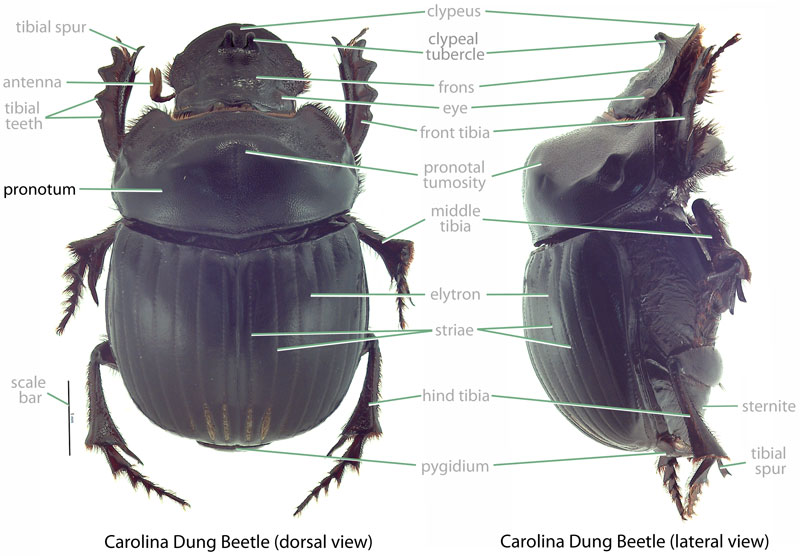 with distinct, impressed, medio-longitudinal line at posteriorposterior:
with distinct, impressed, medio-longitudinal line at posteriorposterior:
towards the rear end; opposite of anterior
margin; anterioranterior:
the front or forward; opposite of posterior
margin smooth, lacking excisions or tubercles. Front tibiatibia:
a segment of the leg articulated with the tarsus and femur
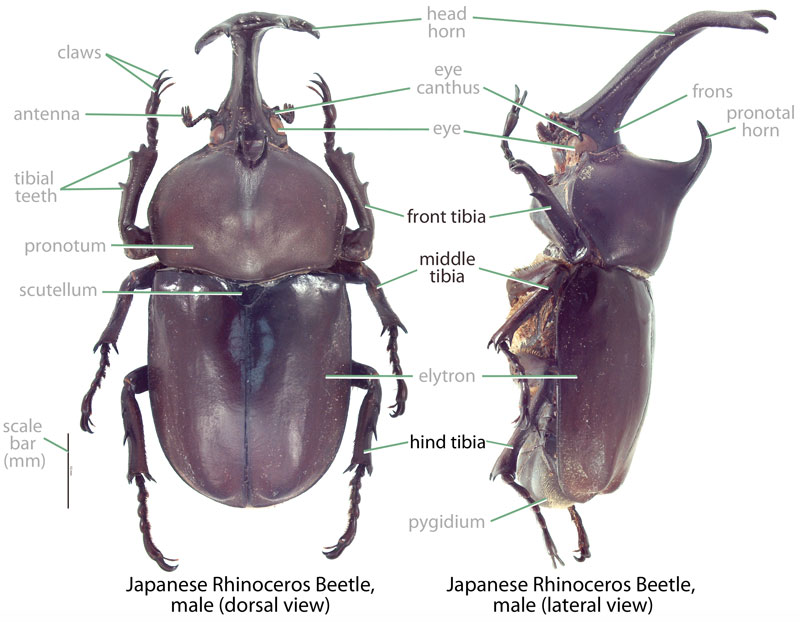 of male gracilegracile:
of male gracilegracile:
thin, slender, light of build
, apexapex:
point or edge furthest from the body
with inner spurspur:
movable, spine-like process, sometimes mobile, often found at or near the tibial apices
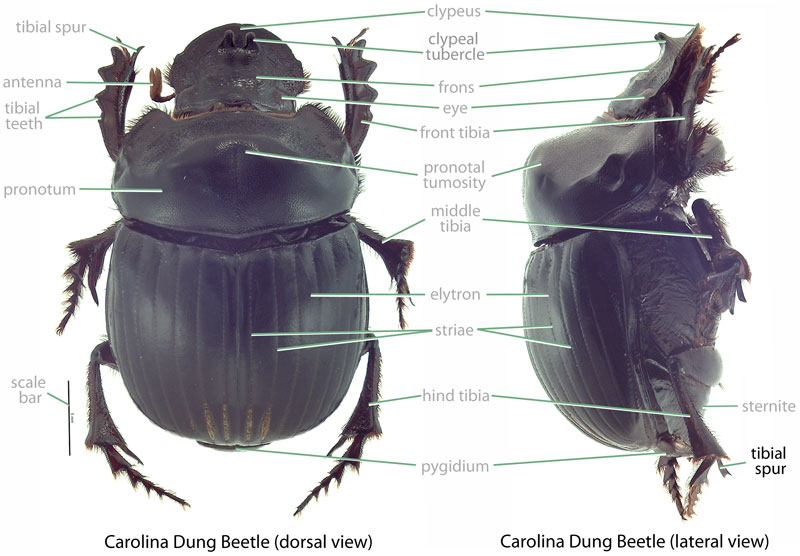 ; female tibiatibia:
; female tibiatibia:
a segment of the leg articulated with the tarsus and femur
 more robust, apexapex:
more robust, apexapex:
point or edge furthest from the body
with a broad, downward curving, inner toothtooth:
a pointed process from an appendage or margin, often in reference to the tibia
(spur lacking).
Undescribed in English. For Oniticellus spp. (Ritcher, 1966Ritcher, 1966:
Ritcher P. 1966. White grubs and their allies: a study of North American scarabaeoid larvae. Oregon State University Monographs, Studies in Entomology 4: 1-219.): Grub C-shaped, with projecting hump, cylindrical, whitish. Maxillamaxilla:
set of paired mouthparts located posterior to the mandibles
with galeagalea:
outer branch or lobe of the maxilla
 and lacinialacinia:
and lacinialacinia:
inner portion of the maxilla distinctly separated. Epipharynxepipharynx:
distinctly separated. Epipharynxepipharynx:
lobe on the interior surface of the labrum or clypeus
with tormaetormae:
in scarab larvae, sclerotized structures on the ends of the clypeolateral suture extending towards the mesal line
united mesallymesally:
at or near midline of body
, anterioranterior:
the front or forward; opposite of posterior
phoba present. AntennaeAntennae:
paired sensory organ on head, formed from numerous segments
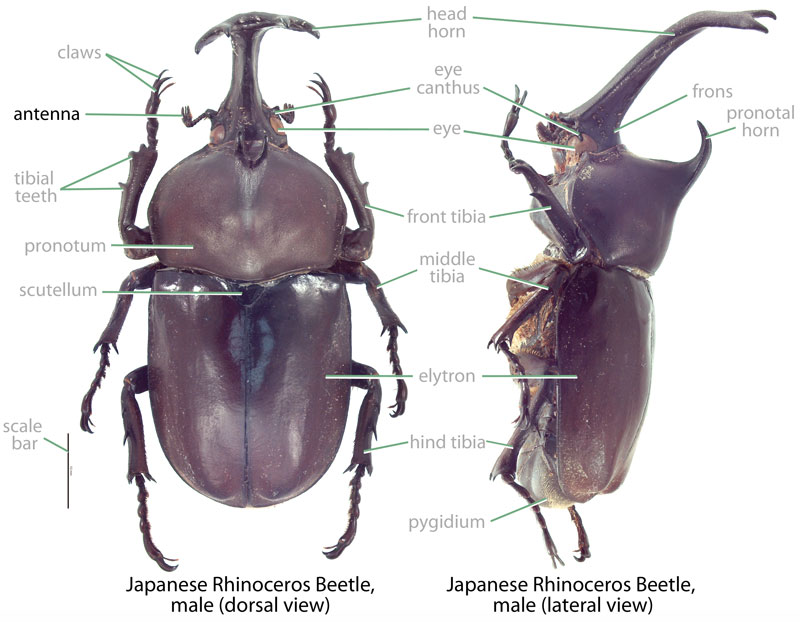 with 4 segments; distaldistal:
with 4 segments; distaldistal:
situated away from the point of articulation, thus usually furthest from the body
segment of antennaantenna:
paired sensory organ on head, formed from numerous segments
 much reduced in size. Legs 2-segmented. Prothoracic shieldprothoracic shield:
much reduced in size. Legs 2-segmented. Prothoracic shieldprothoracic shield:
the chitinous plate behind the head of larvae
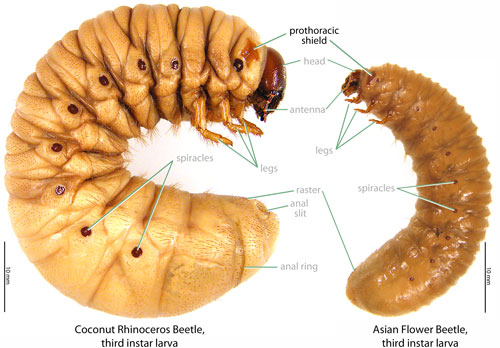 without anteriorly projecting processes. Third abdominal segment without a prominent, conical, dorsaldorsal:
without anteriorly projecting processes. Third abdominal segment without a prominent, conical, dorsaldorsal:
of or relating to the upper surface; opposite of ventral
gibbosity. Venter of last abdominal segment with 2 patches of short, spine-like setaesetae:
small, hair-like structure
.
Tropical Asia. This species is found across a broad area of southern and eastern Asia with records from Burma, southern China, India, Indonesia, Malaysia, Thailand, and Vietnam (Karimbumkara, 2013Karimbumkara, 2013:
Karimbumkara S (editor). 2013. Oniticellus cinctus . Encyclopedia of Life, available from http://eol.org/pages/143000/overview (accessed 14 April 2015).).
None. This species feeds on dung as both adult and larvalarva:
the immature form of an insect; in scarabs, also called grub or white grub; preceded by the egg stage, followed by the pupal stage
 (Klemperer, 1983Klemperer, 1983:
(Klemperer, 1983Klemperer, 1983:
Klemperer H. 1983. Subsocial behaviour in Oniticellus cinctus Coleoptera, Scarabaeidae: effect of the brood on parental care and oviposition. Physiological Entomology 84: 393-402.).
(Klemperer, 1983Klemperer, 1983:
Klemperer H. 1983. Subsocial behaviour in Oniticellus cinctus Coleoptera, Scarabaeidae: effect of the brood on parental care and oviposition. Physiological Entomology 84: 393-402.): Adults of this diurnaldiurnal:
active during daylight hours
scarab are active throughout the year (Venugopal et al., 2012Venugopal et al., 2012:
Venugopal K, Thomas S, Flemming A. 2012. Diversity and community structure of dung beetles (Coleoptera, Scarabaeinae) associated with semi-urban fragmented agricultural land in the Malabar coast in southern India. Journal of Threatened Taxa 4: 2685–2692. DOI: 10.11609/jott.o3074.2685-92), and may show some preference for forested habitat. Females create a brood chamber within a dung pat and create brood balls from the surrounding feces. An egg is implanted within each brood ball, with approximately 20 brood balls created in total. While the larvaelarvae:
the immature form of an insect; in scarabs, also called grub or white grub; preceded by the egg stage, followed by the pupal stage
 grow and feed within the dung balls, the maternal female remains in the brood chamber and continues to apply dung to the surface of the ball. She will drive other female dung beetles from her chamber (though males may be tolerated) and will kill larvaelarvae:
grow and feed within the dung balls, the maternal female remains in the brood chamber and continues to apply dung to the surface of the ball. She will drive other female dung beetles from her chamber (though males may be tolerated) and will kill larvaelarvae:
the immature form of an insect; in scarabs, also called grub or white grub; preceded by the egg stage, followed by the pupal stage
 of other dung beetle species. As the larvaelarvae:
of other dung beetle species. As the larvaelarvae:
the immature form of an insect; in scarabs, also called grub or white grub; preceded by the egg stage, followed by the pupal stage
 develop, their brood balls become both more hollowed and more dry. By the time pupation occurs, the brood ball is a dry, hollow chamber. The maternal female remains in the brood chamber until the larvaelarvae:
develop, their brood balls become both more hollowed and more dry. By the time pupation occurs, the brood ball is a dry, hollow chamber. The maternal female remains in the brood chamber until the larvaelarvae:
the immature form of an insect; in scarabs, also called grub or white grub; preceded by the egg stage, followed by the pupal stage
 emerge as adults.
emerge as adults.
None. This species recycles dung and is beneficial for ranching and farming in Hawaii. Being a dung feeder, this species poses no threat to crop or ornamental plants. Additionally, this species is not a threat to native dung beetles because none are known from Hawaii or Guam.
Established. There is conflicting information regarding the arrival of this species to Hawaii. Markin and Yoshioka (1998) reported that this species was intentionally introduced to Big Island in 1956 and Oahu in 1957-1958 to help control populations of the horn fly (Haematobia irritans), a biting pest of livestock. However, it has also been reported that specimens collected on Oahu in 1965 represent the first record of this species in Hawaii (Hawaiian Entomological Society, 1967Hawaiian Entomological Society, 1967:
Anonymous. 1967. Notes and exhibitions. Proceedings of the Hawaiian Entomological Society 19: 321. full text (accessed 2015)), and that the species is adventiveadventive:
a species that has recently arrived to a new location; may or may not be invasive
to the state (Harris et al., 1982Harris et al., 1982:
Harris R, Onaga K, Blume R, Roth J, Summerlin J. 1982. Survey of beneficial insects in undisturbed cattle droppings on Oahu, Hawaii. Proceedings of the Hawaiian Entomological Society 24: 91-95.). It does appear that this beetle is established on both islands, though it is rare on Oahu (Toyama and Ikeda, 1976Toyama and Ikeda, 1976:
Toyama GM and Ikeda JK. 1976. An evaluation of fly predators at animal farms on leeward and central Oahu. Proceedings of the Hawaiian Entomological Society 22: 369-384.).
Not established or recorded. There are no records of this species from Guam.
It is unclear how this species arrived to Hawaii. It was probably intentionally introduced. It is possible that adults or larvaelarvae:
the immature form of an insect; in scarabs, also called grub or white grub; preceded by the egg stage, followed by the pupal stage
 were transported on farm or ranching supplies or in natural, manure-based fertilizers.
were transported on farm or ranching supplies or in natural, manure-based fertilizers.
Oniticellus cinctus is one of two Oniticellus species known from Hawaii, the other being Oniticellus militaris. These two scarabs are separated by examining the head armature (O. cinctus lacking horns or distinct ridges in both males and females versus O. militaris with a short horn in males and a transversetransverse:
extending horizontally across a surface
ridge in females), elytral color (O. cinctus with elytraelytra:
the hardened and chitinous wing-cover of a beetle that protect and overlie the flight wing
black bordered with tan versus O. militaris which is dark brown with broken, tan stripes), and the form of the pronotumpronotum:
the dorsal surface of the thorax
 (O. cinctus lacking sinuatesinuate:
(O. cinctus lacking sinuatesinuate:
gently curved (specifically of margins or edges); often in reference to the clypeus
excisions versus anterioranterior:
the front or forward; opposite of posterior
margin with sinuatesinuate:
gently curved (specifically of margins or edges); often in reference to the clypeus
excisions in O. militaris).
Oniticellus diadema Wiedemann, Oniticellus serratipes Drury, Scarabaeus cinctus Fabricius
Report your observation of this beneficial species at our iNaturalist project.